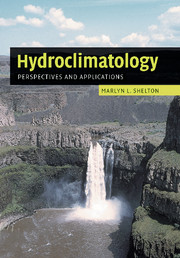Book contents
- Frontmatter
- Contents
- Preface
- 1 The realm of hydroclimatology
- 2 The climate system and the hydrologic cycle
- 3 Measuring hydroclimate atmospheric components
- 4 Measuring hydroclimate terrestrial components
- 5 Remote sensing and hydroclimate data
- 6 The runoff process and streamflow
- 7 Hydroclimate spatial variations
- 8 Hydroclimate temporal variations
- 9 Floods: the hydroclimatic extreme of excessive moisture
- 10 Drought: the hydroclimatic extreme of deficient moisture
- References
- Index
8 - Hydroclimate temporal variations
Published online by Cambridge University Press: 06 July 2010
- Frontmatter
- Contents
- Preface
- 1 The realm of hydroclimatology
- 2 The climate system and the hydrologic cycle
- 3 Measuring hydroclimate atmospheric components
- 4 Measuring hydroclimate terrestrial components
- 5 Remote sensing and hydroclimate data
- 6 The runoff process and streamflow
- 7 Hydroclimate spatial variations
- 8 Hydroclimate temporal variations
- 9 Floods: the hydroclimatic extreme of excessive moisture
- 10 Drought: the hydroclimatic extreme of deficient moisture
- References
- Index
Summary
Temporal scale
The history of the Earth's hydroclimate is very complex and efforts to understand hydroclimatic processes through time are hindered by the relatively short existence of humans on the planet. The ability to quantify climate variability is fundamental to understanding past and future hydroclimates and to developing a comprehensive perspective of the range and temporal variability of hydroclimatic processes. In the absence of direct observations of climate variables, alternative approaches have been devised to extract climatic information from natural recording systems to develop a climatic record of sufficient duration to expand our understanding of the climate system, climate variability, and hydroclimate variability.
Temporal variability is an inherent characteristic of climate and hydroclimate, and empirical evidence shows that most hydroclimatic processes deviate from stationarity in the long term. However, most historical records are too short to accurately reveal the trends, oscillatory behavior, persistence, and sudden shifts from one stationary state to another that characterize long records (Lockwood, 2001; Sveinsson et al., 2003; Rybski et al., 2006). Examination of climate variability is complicated further by the absence of a universally accepted distinction between the terms “variability” and “change”. Both terms refer to fluctuations in climate from some expected or previously defined mean climate state. Variability refers to the oscillations, or the pattern of fluctuations, about some specified mean value while change refers to a secular trend producing a displacement of the average. Distinctions can only be made relative to the time scales of concern.
- Type
- Chapter
- Information
- HydroclimatologyPerspectives and Applications, pp. 262 - 304Publisher: Cambridge University PressPrint publication year: 2008



